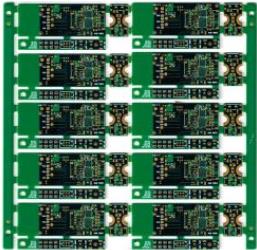PCB is an important carrier of electronic components and an important circuit connection component, and has been developed for a long time. According to the number of printed circuit boards, PCBs can be divided into single-sided PCBs, double-sided PCBs, and multilayer PCBs. Until today, PCB has reached a fairly good level. Many improvements and optimizations in PCB technology have been born.
High-density interconnect PCB:
In the early 1990s, Japan and the United States took the lead in applying high-density interconnection technology, namely HDI. The manufacturing process is to use double-sided or multi-layer boards as the core board, and use multi-layer overlap and stacking technology to absolutely insulate the PCBs, thereby manufacturing high-density, high-integration printed circuit boards.
The five main characteristics of this kind of PCB are micro, thin, high frequency, fine and heat dissipation. According to these characteristics, continuous technological innovation is the development trend of today's high-density printed circuit board manufacturing. "Thinness" determines the basis for the survival of high-density electronic circuits.

Its birth directly led to and influenced the production of fine and micro technology. The fine wiring of each layer, fine micro-drilling and insulation design determine whether the high-density PCB can adapt to high-frequency operation and is conducive to reasonable thermal conductivity. This is also an important method for judging the degree of integration of electronic circuits on ultra-high-density electronic circuit boards.
High-density arbitrary layer interconnection PCB:
For HDI with different hierarchical structures, there are big differences in process manufacturing. Generally, the more multi-layer structure, the more complex and complicated it is, the more difficult it is to manufacture. At present, the connection between boards has several main technological characteristics, namely "trapezoidal connection", "staggered connection" and "span connection". "Layer connection" and "Layer connection" will not be described in detail here. Ultra-high-density interconnection of any layer of printed circuit boards is a printed circuit board in high-end products. Its biggest demand comes from the market's demand for electronic products that require light weight, thinness and multi-function functions, such as smart phones, notebook computers, digital cameras and LCD TVs.
Integrated printed circuit board:
Integrated printed circuit board technology separates one or more electronic components integrated in the printed circuit board structure, which makes the integrated printed circuit board system function of the printed circuit board improve the reliability of the electronic product system function to a certain extent, The signal transmission performance is good, which effectively reduces the production cost, and the production technology has the advantage of green and environmental protection. It is one of the miniaturization technologies of electronic system integration and has huge market development potential.
High heat dissipation metal substrate:
By using the metal substrate material itself with better thermal conductivity, the heat source is generated by high-power components. Its heat dissipation performance is related to the structural layout of the multi-chip package and the reliability of the component package.
As a high-end PCB, the metal PCB and its metal substrate with high heat dissipation are compatible with the SMT process, thereby reducing the size, hardware and assembly costs of our products, and also replacing the fragile ceramic substrate and improving the rigidity. At the same time, it has good mechanical durability and shows strong competitiveness on many thermally conductive substrates, so the application prospect is very broad.
High frequency and high speed PCB:
As early as the end of the 20th century, high-frequency, high-speed PCBs have been used in the military field. In the past ten years, due to the transfer of a part of the high-frequency communication frequency band for military use to civilian use, civil high-frequency and high-speed information transmission technology has made great progress, which has promoted the progress of radio technology. All walks of life in electronic information technology. It has the characteristics of remote communication, remote medical operation, and automatic control and management of large logistics warehouses.
Rigid-flex printed circuit board:
In recent years, high-performance, multi-functional and compact and lightweight electronic devices have been rapidly developed. As a result, there is an increasing demand for miniaturization and high density of electronic components and PCBs used in electronic devices. In order to meet these requirements, innovated the laminated multilayer PCB manufacturing technology of rigid PCBs, and applied various laminated multilayer PCBs in electronic equipment. However, portable devices, digital video cameras and other mobile devices not only speed up the cycle of adding new features or performance improvements, but also tend to adopt small and lightweight designs with the highest priority. Therefore, the space provided for the functional components in the housing is only a limited and narrow space, and the space must be effectively used to the greatest extent. In this case, several small laminated multilayer PCBs are usually combined with flexible PCBs or cables connecting them to form a system structure, which is called an analog rigid-flex PCB. Rigid-flex printed circuit boards also use this combination to cut out special spaces, which are functional composite multilayer printed circuit boards that integrate rigid printed circuit boards and FPC.
in conclusion:
These are the most widely used technologies on the market today. With the development of electronic technology, there will be more innovative and improved PCB manufacturing technologies in the future.